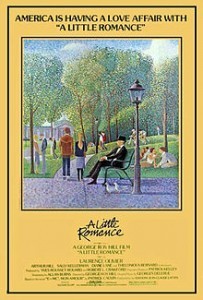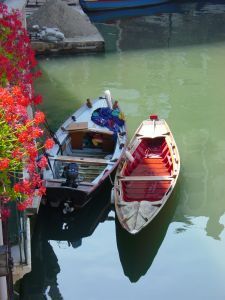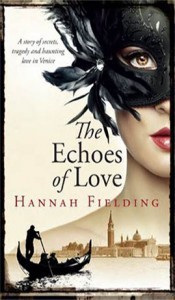Hannah Fielding's Blog, page 121
October 3, 2013
Forbidden love
 Pansies are one of my favourite flowers. In Victorian days if an admirer left a maiden a pansy, in symbol, it was equal to saying to her: ‘I am thinking of our forbidden love.’ But it is considered a bad luck gift to a man
Pansies are one of my favourite flowers. In Victorian days if an admirer left a maiden a pansy, in symbol, it was equal to saying to her: ‘I am thinking of our forbidden love.’ But it is considered a bad luck gift to a man
October 2, 2013
A Venetian lover, and writer: Casanova
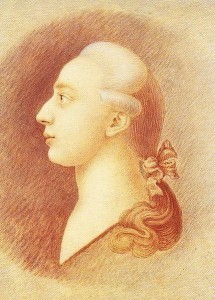 What does the word ‘Casanova’ mean to you? Most probably, you recognise it as an established term in the English language to mean lover, usually promiscuous and unscrupulous, and you have some idea that the term derives from the name of a man. A character in a book of old, perhaps?
What does the word ‘Casanova’ mean to you? Most probably, you recognise it as an established term in the English language to mean lover, usually promiscuous and unscrupulous, and you have some idea that the term derives from the name of a man. A character in a book of old, perhaps?
In fact, Casanova was no character, but a writer: the book for which he is remembered is Storia della mia vita, an autobiography: the writer is his character. The book is rich in detail of the social life of Europeans in the eighteenth century, and as such is widely appreciated by historians. But it is another element that most lodged itself in the collective consciousness: Casanova’s frank accounts of his seduction of women, often elaborate, usually leading to complications.
Giacomo Casanova was born in 1725 inVeniceto actor parents, at a time whenVenicewas ‘the pleasure capital ofEurope’. He grew up in the flamboyant art scene, shaped by the Carnival and the many gambling houses and courtesans. But despite his growing love for gambling, Casanova was no dropout – between the ages of 12 and 17 he attended theUniversityofPadau, and he graduated with a degree in law. For some time he ran his own practice, but the further he climbed in society, under the wing of his patron, the more society itself became the object of his interest – and especially the pretty, flirtatious women batting their eyes at the tall, attractive, well-turned-out young man. Soon enough, he was a ‘professional gambler’ and a notorious ladies’ man, which would lead him on a bed-hopping path aroundEurope. He ended his days inBohemia, and spent his final years lonely and gloomy, penning his memoirs.
The autobiography, which uncut totalled 12 volumes, begins:
I begin by declaring to my reader that, by everything good or bad that I have done throughout my life, I am sure that I have earned merit or incurred guilt, and that hence I must consider myself a free agent. … Despite an excellent moral foundation, the inevitable fruit of the divine principles which were rooted in my heart, I was all my life the victim of my senses; I have delighted in going astray and I have constantly lived in error, with no other consolation than that of knowing I have erred. … My follies are the follies of youth. You will see that I laugh at them, and if you are kind you will laugh at them with me.
Whether readers since have laughed at him, or with him, or simply been appalled by his scrapes, Giacomo Casanova has become one of the most famous Venetians who ever lived, and he is inextricably linked to the romance of his home city. I thought of him often as I wrote my own love story set in Venice. But as for my hero, Paolo – there is no Casanova in him.
September 30, 2013
Vote for my hero in the Men of Omnific Ultimate Boyfriend Smackdown
Today’s the day:
Vote Rafe from my novel, Burning Embers!
The Smackdown is hosted at Love Between the Sheets, where you can vote, and Rafe is sponsored by the lovely One More Chapter. Be sure to take a look to see why Rafe’s the ultimate boyfriend.
And win yourself some great prizes while you’re at it!
The Bridge of Sighs
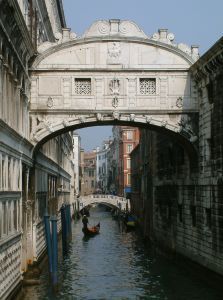 The Bridge of Sighs is a famous Venetian landmark. With such a wonderfully romantic name, you no doubt expect it to be one of the many ornate bridges that cross the canals, a place to stop beneath a vintage street lamp and take a moment to watch gondolas drift along and the play of sunlight or moonlight on the gentle blue waters. But in fact, the sighs in question are not those of misty-eyed lovers, but of convicts.
The Bridge of Sighs is a famous Venetian landmark. With such a wonderfully romantic name, you no doubt expect it to be one of the many ornate bridges that cross the canals, a place to stop beneath a vintage street lamp and take a moment to watch gondolas drift along and the play of sunlight or moonlight on the gentle blue waters. But in fact, the sighs in question are not those of misty-eyed lovers, but of convicts.
TheBridgeofSighsis an enclosed bridge, made of limestone, that was built to traverse the Rio di Palazzo and join together a prison and interrogation rooms of the doge’s palace. The view from the small, square windows of the city was the very last a criminal would see before incarceration.
It was English writer Lord Byron who named the bridge, back in the nineteenth century, when he wrote this stanza of Childe Harold:
I stood in Venice, on the Bridge of Sighs;
A palace and a prison on each hand;
I saw from out the wave her structure rise
As from the stroke of the enchanter’s wand:
A thousand years their cloudy wings expand
Around me, and a dying Glory smiles
O’er the far times, when many a subject land
Look’d to the wingèd Lion’s marble piles,
Where Venice sate in state, throned on her hundred isles.
Interestingly, there are several other bridges worldwide named ‘The Bridge of Sighs’. One such bridge is in Oxford, England, connecting two parts of the University. But it is the Venetian bridge that is the source of romantic legend: supposedly, if you kiss your lover on a gondola at sunset under the bridge as the air rings with the bells of St Mark’s Campanile, you will live happily ever after. Such a lovely idea – no wonder it formed the basis of a film, A Little Romance (1979), starringDiane Lane and Laurence Olivier, in which two lovers facing adversity in their union at every turn travel toVenice to cement their relationship beneath the bridge.
The bridge is visible from either Canonica Bridge or the Ponte della Paglia. But personally, I recommend seeing it from a gondola. At sunset. When the bells toll. As you pass underneath, look closely at the sculpted details, and seek out the one smiling face. Perhaps it is Cupid’s.
September 29, 2013
Autumn in Venice: What to see
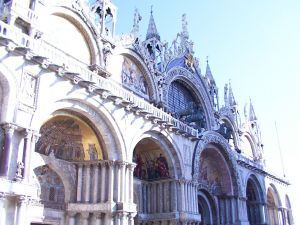 Were I asked to recommend a European city for a weekend break, Venice would undoubtedly be in my top five – what other city in recent years has so fired up my imagination and romanticism that I have put pen to paper and situated a love story there? The Echoes of Love, out in November, opens in this beautiful, historical place, and the city is very much part of the fabric of the story – were there no Venetian backdrop, there would be no Venetia and Paolo story to tell.
Were I asked to recommend a European city for a weekend break, Venice would undoubtedly be in my top five – what other city in recent years has so fired up my imagination and romanticism that I have put pen to paper and situated a love story there? The Echoes of Love, out in November, opens in this beautiful, historical place, and the city is very much part of the fabric of the story – were there no Venetian backdrop, there would be no Venetia and Paolo story to tell.
Many people visit Venicein the spring and summer, when in the mood for sultry passion, and in September, to see the Biennale (see http://www.hannahfielding.net/?p=2721), which is a huge event in the Italian cultural calendar that pulls in thousands of international visitors. And yet, an out-of-season visit to the city is by no means to be dismissed. The streets are quieter. You can enjoy a greater degree of freedom and intimacy in an art gallery. You have a greater pick of cafes and restaurants. You mingle more easily with native Venetians, who venture out now the crowds have dispersed.
If you are travelling toVenicethis autumn, here’s a glimpse of what’s on in the city’s artistic calendar:
The beautiful Ca’ D’Oro gallery (http://www.cadoro.org/) is running a ‘From Giorgio Franchetti to Giorgio Franchetti’ exhibition until the end of November. Both Franchettis were great art aficionados, one in the nineteenth century, and the latter in this one, and this is a wonderful art collection bringing together classic and modern pieces.
The Accademia Gallery (http://www.gallerieaccademia.org/) has collated a groundbreaking exhibition: ‘Leonardo: Man, Nature and Science’ (to 1 December). All of Leonardo da Vinci’s drawings have, for the first time in many decades, been brought together.
Have you see Titian’s painting ‘Girl in the Blue Dress’, known as La Bella? No? Then head to the Palazzo Grimani by 8 December (www.palazzogrimani.org).
If modernist and surrealist art, such as that by Picasso, Magritte, Max Ernst and Jackson Pollock, is right up your street, you’ll love the Guggenheim Venice (www.guggenheim-venice.it). The latest exhibit is on French avant-garde artwork of the late 19th century. Be sure to check out the museum shop, which has one of the best ranges in the city.
And here are some events to catch:
Sagra del Mosto Festival (first Sunday of October): This annual event is in honour of Saint Erasmus. Head to the largest island in the lagoon, Sant’Erasmo, for a feast (www.turismovenezia.it).
Venicemarathon (27 October): Watch (or join?) some 7,000 runners as they pound through the city’s streets (www.venicemarathon.it).
Festival of the Madonna of the Salute (21 November): A religious procession to remember the 100,000 people who died in a plague in the city in the seventeenth century. You’ll find a traditional stew called castradina on offer in restaurants on that day.
September 27, 2013
Book review: The One Plus One by Jojo Moyles
From the blurb:
One single mum.
One chaotic family.
One handsome stranger.
One unexpected love story.
I was delighted to receive an advance copy of this book from the publisher to review, because I love the author’s earlier works. And this one did not disappoint. In fact, if I could give it six stars out of five, I would!
This is a sublimely intelligent women’s fiction novel. It’s funny. It’s heart-warming. It’s moving. It’s poignant. It’s romantic. It’s gritty and real to the point that characters exist beyond the pages – in your mind and heart.
The story follows single mum, Jess, who’s been ever so compassionate about her ‘depressed’ husband leaving her in dire financial straits for two years while he goes home to rest with his mother; her stepson Nicky, who’s something of a loner given his eyeliner-wearing and is being horrendously bullied by the estate’s roughest family; and her daughter, Tanzie, a maths genius who’s desperate to take a scholarship on offer at a local private school with an excellent maths programme, but is facing her teens at the rough comprehensive instead given that her mother just can’t afford the £500-a-term school fees.
Then there’s Ed – in the eyes of his cleaning lady, Jess, he has it all: lots of money, great job in London, posh car, plush homes, expensive clothes and a superior attitude to match. But it soon becomes clear Ed is in real trouble. Due to a messy relationship with a money-grabbing woman, he’s facing prosecution for insider dealing, and at best a large enough fine to wipe out his fortune, at worst a lengthy jail term.
So what happens when you squeeze a desperately broke mother, a withdrawn and wounded teenager, a little girl desperate to find her way to the good school, a somewhat unwilling stranger whose life is crumbling around him and a very large, very smelly dog into a car, and send them on an excruciatingly slow journey from the south of England up to Scotland, where Tanzie can participate in a maths competition whose winnings could change her life? The answer is: love. Through the intensity of the journey, bonds are formed, barriers are shed, walls crumble, and each of the characters goes on an inner journey that will see their life change for ever.
I’ll say no more on the plot – I don’t want to spoil it for you – but suffice it to say that this is a wonderfully executed story that’s startling in its realism and power to affect. I can’t remember the last time I was quite so keen to pick up the Kindle and read some more – something about the writing style and the characters really touched me. I think the use of multiple points of view (we’re told the story from all four characters’ perspectives) really makes this book stand out, and allows us to care deeply about each character.
If you like modern women’s fiction (I don’t want to call it ‘chicklit’, because it’s not a fluffy, silly book, but a well-written one), you’ll adore this book. It’s one to keep on the shelf, and read again… and again.
The One Plus One is available now from Amazon; click on the book cover below to visit the store.
September 26, 2013
Little puffs of white
September 25, 2013
Ten must-watch films for their Venice setting
A large part of my new book, The Echoes of Love, is set in Venice, Italy. What better excuse to riffle through the DVD collection and watch some classic films to fire up the imagination, all in the name of research?
If, like me, you love the backdrop of Venice and find it wonderfully cultural and romantic, you’re bound to enjoy these movies:
Summertime (1955): The beautiful Katharine Hepburn falls in love with Venice, and a handsome antiques dealer.
Brideshead Revisited (1981): Laurence Olivier turns his back on Britain for Venetian freedom.
The Wings of the Dove (1997): A wonderful costume drama with sweeping scenes of grand palaces and quaint little side streets.
Dangerous Beauty (1998): A tale of 16th-century Venetian love and lust.
The Children of the Century (1999): Two French literary icons in Venice: George Sand and Alfred de Musset. Worth watching for the 19th-century Venice setting, which is beautifully recreated.
Bread and Tulips (2000): An Italian take on Venetian romance, where a woman finds herself in the city of love.
The Italian Job (2003): For the views afforded by a boat chase through the canals.
William Shakespeare’s The Merchant of Venice (2004): Decadent renaissance Venice plus a wonderful cast including Joseph Fiennes, Jeremy Irons and Al Pacino.
Casanova (2005): Featuring the late, great Heath Ledger and sultry Venetian scenery.
The Tourist (2010): A romantic thriller that’s worth watching solely for the Venetian backdrop.
Would you add any films to this list? Which movie most shouts ‘Venice’ to you? I’d love to hear your thoughts.
September 24, 2013
The ultimate accolade for the writer
We live at a time when the cult of the celebrity has become so normalised and strong that it has spilled out of show business and into the domain of publishing. No longer is a career choice to be a writer one that guarantees you a nice, quiet life writing alone in your romantic garret: to be an author, these days, is to be ‘out there’, interacting with readers and other writers. It is also, once you reach a certain pinnacle of success, a job that can earn you a range of accolades, from the highly respected to the weird and wonderful.
Following are some examples of author accolades. I wonder, which of the following would you, as an author, most like to have? Which, as a reader, do you think is the highest honour? Which would you add to the list, real or fantasy? I would love to hear your thoughts!
Fans of the Twilight series already owned all of Stephenie Meyer’s novels. So what to do when the publishers republished them all, but this time with white covers, not black, and red-edged pages? Well, flock out and buy the books all over again is the answer!
The award
Whether it’s a Booker Prize or a book voucher from a local newspaper’s book competition, what author doesn’t love an award?
Take the recent City of Bones film based on Cassandra Clare’s bestselling novel series. Cassandra told interviewees that when she found out her book was getting published, she went out for a drink with friends. And when she found out a film was to be made of her book? She flew all her friends toFrance for a huge party!
Whether it’s a book soundtrack, or simply a concept or line from your book that inspires a musician, what a way to be immortalised. For example, consider these book-inspired songs: ‘Don’t Stand So Close to Me’ by The Police (inspired by Vladimir Nabokov’s Lolita); ‘Animals’ by Pink Floyd (inspired by George Orwell’s Animal Farm); and ‘All Along the Watchtower’ by Bob Dylan (inspired by Mary Shelley’s Frankenstein).
On Amazon, for example, for a mere £119 (!) you can purchase a Barbie Galadriel doll from Tolkien’s The Lord of the Rings.
… or a t-shirt, or a cushion, or a poster, or a chocolate bar. Take a look at http://www.theliterarygiftcompany.com for a vast array of such merchandise.
JK Rowling, for example, received an honorary degree fromHarvardUniversityfollowing the success of the Harry Potter series.
The namesake
Whether a college, a library, a street, a park or – if you’re Scottish sci-fi author Iain Banks, !
In the UK, for example, popular children’s author Roald Dahl is remembered fondly on his birthday, 13 September, with events held nationwide. See http://www.roalddahlday.info/.
A museum, a visitors’ centre or perhaps even a ride at a theme park.
Rochester, England, for example, is home to two annual festivals each year honouring local writer Charles Dickens: the Dickens Summer Festival and the Dickensian Christmas Festival, set around the streets and castle.
September 22, 2013
Five things I love about the run-up to my books’ publication (and the best moment post-publication)
The period, in 2011/12, that began with signing a publishing contract for my debut novel, Burning Embers, and ended with holding the said novel in my hands was one of the most exciting and memorable of my life. And in the past months, I’ve been fortunate enough to experience the process all over again, as my next novel, The Echoes of Love, nears its publication date of November 2013.
Today, I thought I’d share with you the highlights for me of taking a body of work which represents countless hours of effort and tender crafting (but is, effectively, a simple word document) and transforming it into a ‘proper’ book.
1. Signing the contract
Usually, signing paperwork is a simple and somewhat tedious administrative task. Not when it’s for book publication, I find! Then, signing my name leaves me with a little, secret smile on my face for the day.
2. Finalising the text
By the time my book is in the editorial process, it’s been a while since I finished writing it. So I can return to it with fresh eyes, and work with the editor to polish it until it shines. It’s at this point the words shift from representing something I wrote mostly for me, because I loved the story, to that which others will read and – I hope – enjoy.
3. Creating the cover
I’m passionate about art in all its forms, and to me book cover design is very much an art form. For The Echoes of Love, I loved discussing with the publishing team the key themes of my book and the feel I’d love the cover to convey. Subsequently, I received several covers to comment on, and I was delighted with them all – but most especially with the one that was chosen. And then, of course, followed the cover reveal day. Such fun!
4. Laying the path for marketing
Back when Burning Embers was in the publishing pipeline, marketing was a whole new, unexplored world for me – and, I confess, a little daunting in its magnitude. But for my new book, I’m positively enjoying the process of drawing up a marketing plan and sharing news. The Echoes of Love is set in a most romantic country,Italy, and there is so much to share about the setting and characters and background in the coming months. I’m looking forward to it.
5. Planning the publication party
At the end of the process, which really began the day I conceived the idea for the book, a celebration is in order! My biggest champions are my husband, my son and my daughter, and they are all as excited as I am when a courier arrives with the box of first editions.
The moment I’ve awaiting most eagerly…
So after the whirlwind of the writing and then the publishing processes, what next? The best moment of all for me: readers reading the book. Nothing gives me greater pleasure than reading a review of my novel. With Burning Embers, I have been quite swept away by the reviews, and I so hope that my readers will similarly get lost in the world of Paulo and Venetia in The Echoes of Love.
And then?
Well, I write another book, of course! My next is set in another eminently romantic country: Spain. And of course, I will share news of its publication on this blog as soon as I am able.





